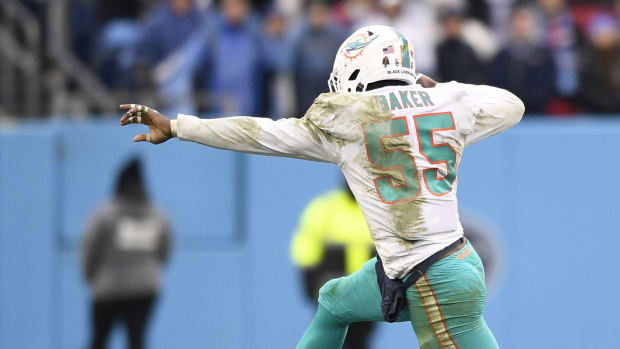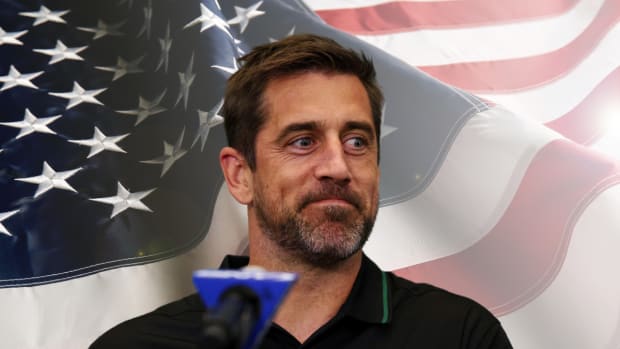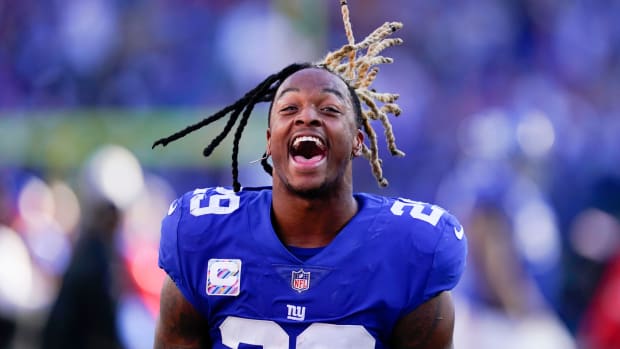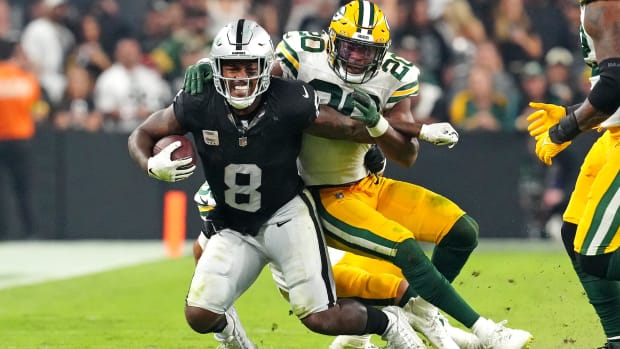The Case for Aaron Rodgers to Win NFL MVP
GREEN BAY, Wis. – Aaron Rodgers laid out his case to win his fourth NFL MVP rather succinctly.
“A lot of times, it goes to the best player on the best team, and we’re the best team,” the Green Bay Packers’ star quarterback said before last week’s game at Detroit.
Rodgers, especially down the stretch, was nothing short of magnificent. In carrying one of the most-injured rosters in the NFL to the best record in the league, he put his stamp on what could be the league’s first back-to-back MVP seasons since Peyton Manning in 2008 and 2009.
The debate between Rodgers and Tampa Bay Buccaneers quarterback Tom Brady is fascinating. Brady put up some absurd numbers in adding to his resume as the greatest to ever play the game. He led the NFL with 5,316 passing yards and 43 touchdowns. His 485 completions are the most in league history. The Buccaneers went 13-4.
While Brady wins the MVP debate on sheer volume, Rodgers wins it on efficiency. For the second consecutive season, he led the NFL in passer rating, touchdown percentage and interception percentage. In the Super Bowl era, it’s a feat accomplished only five times – including by Brady in 2010. With that, the Packers also finished 13-4 while using the last game of the season as a high-intensity practice.
Brady crushes Rodgers (and everyone else) by the numbers because he threw 47 passes more than any other quarterback and 188 more passes Rodgers. Give Rodgers the same number of attempts as Brady, and Rodgers would have thrown for 5,572 yards and 50 touchdowns and beaten Brady’s completions record with 494.
With 37 touchdowns vs. four interceptions, Rodgers’ 9.25 touchdowns per interception is the seventh-best mark in NFL history. Not that it should have any bearing on this year’s award, but Rodgers owns six of the best 12 seasons of all-time in that category. Rodgers threw two-plus touchdown passes with zero interceptions in seven consecutive games to close the season, the second-longest streak in NFL history, and 13 games overall, breaking his own record.
Setting aside the volume-based numbers, here’s the tale of the tape:
Rodgers – Stat – Brady
68.9 – Completion Percentage – 67.5
7.75 – Yards Per Attempt – 7.39
7.0 – Touchdown Percentage – 6.0
0.8 – Interception Percentage – 1.7
9.25 – TD/INT Radio – 3.58
111.9 – Passer Rating – 102.1
68.8 – ESPN’s QBR – 68.5
13-2 – Record When Playing More Than One Half – 13-4
This isn’t just about the numbers, though. It’s how those numbers were accomplished and what they meant to the team.
Rodgers carried an injury-plagued team to the best record in the NFL. One thing is practically universal: Most fans think their team suffered more injuries than most, if not the rest, of the league. The subscription site ManGamesLost.com takes care of that. Its formula uses the Approximate Value of each player out of the lineup and the number of games that player missed. That way, the absence of an All-Pro carries more weight than that of a below-average starter or bottom-of-the-depth chart backup. By its calculations, the Baltimore Ravens were the most-injured team by a wide margin. The Packers were the second-most-injured team, also by a wide margin. The Buccaneers were the 15th-most-injured team.
Last season, seven Packers were selected for the Pro Bowl: Rodgers, left tackle David Bakhtiari, cornerback Jaire Alexander, receiver Davante Adams, left guard Elgton Jenkins, outside linebacker Za’Darius Smith and running back Aaron Jones. This season, Bakhtiari missed the first 16 games with the ACL tear sustained before last year’s playoffs. Smith missed the final 16 games with a back injury that required surgery. Alexander missed the final 13 games with a shoulder injury. Jenkins missed nine games with ankle and ACL injuries. Jones missed two games and was slowed for five others by an MCL injury. That’s 56 games missed by All-Pro/Pro Bowl players due to injuries.
And that’s before you get to some other key losses, such as Robert Tonyan, who tied Travis Kelce for the tight ends lead in touchdowns last year but missed the final nine games with a torn ACL. Big-play receiver Marquez Valdes-Scantling missed six games, reliable slot receiver Randall Cobb missed five and right tackle Billy Turner missed four.
In a perfect world, the Packers would have lined up with Bakhtiari at left tackle, Jenkins at left guard, rookie Josh Myers at center, rookie Royce Newman at right guard and Turner at right tackle. Bakhtiari (16), Jenkins (nine), Myers (11), Newman (zero) and Turner (four) combined to miss 40 of a possible 85 games.
On Oct. 28, the Packers went to Arizona to face the 7-0 Cardinals. Not only were Bakhtiari and Myers out with their knee injuries, but Adams, Valdes-Scantling and Allen Lazard were inactive and Tonyan suffered his torn ACL. The Packers won, anyway, with Cobb, Equanimeous St. Brown, Juwann Winfree and Amari Rodgers playing receiver.
Even with all those injuries, this is worth noting: In games against teams that reached the playoffs, Rodgers threw 10 touchdowns and one interception as the Packers went 5-0. Brady threw nine touchdowns vs. three interceptions as the Bucs went 4-1.
There’s no arguing that Rodgers is blessed to have Adams as his No. 1 receiver and Jones and AJ Dillon serving as a one-two punch in the backfield. That’s as good as it gets. But Brady spent the bulk of the year throwing to Chris Godwin, Mike Evans and Rob Gronkowski. Godwin is a young star, Evans is on a Hall of Fame trajectory and Gronkowski is arguably the greatest tight end in NFL history.
Brady had three Pro Bowlers (right tackle Tristan Wirfs, left guard Ali Marpet and center Ryan Jensen) and a high-quality left tackle (Donovan Smith) providing protection. Every member of their starting line played more than 1,000 snaps, with Marpet playing a unit-low 87.7 percent.
Rodgers spent a significant chunk of the season playing behind four backups, including a third-string left tackle who had never played a meaningful snap from scrimmage until being forced to start. Only two of Green Bay’s linemen, guards Newman and Jon Runyan, played 1,000 snaps and more than 82 percent.
Brady also benefitted from a better defense. With their entire starting group back from last year’s championship season, the Buccaneers finished fifth in points, seventh in yards per play and – critically in a pass-centric league – fourth in passing yards per play. The Packers finished 15th in points, 16th in yards per play and fifth in passing yards per play. Green Bay’s defense started fast but faltered late. Rodgers played his best ball of the season down the stretch to pick up the slack. That’s what an MVP is supposed to do.
An MVP must play great and be the rising tide that lifts all boats. Rodgers and Brady led their teams to 13-win seasons. Both players, as always, were sensational. By overcoming a beat-to-hell roster, a slumping defense and a typically unreliable special teams, Rodgers deserves to win his fourth MVP – one behind Manning’s record.
Nobody has won NFL MVP and a Super Bowl in the same season since Kurt Warner in 1999. For two of the greatest players the game has ever seen, that’s history worth making.





